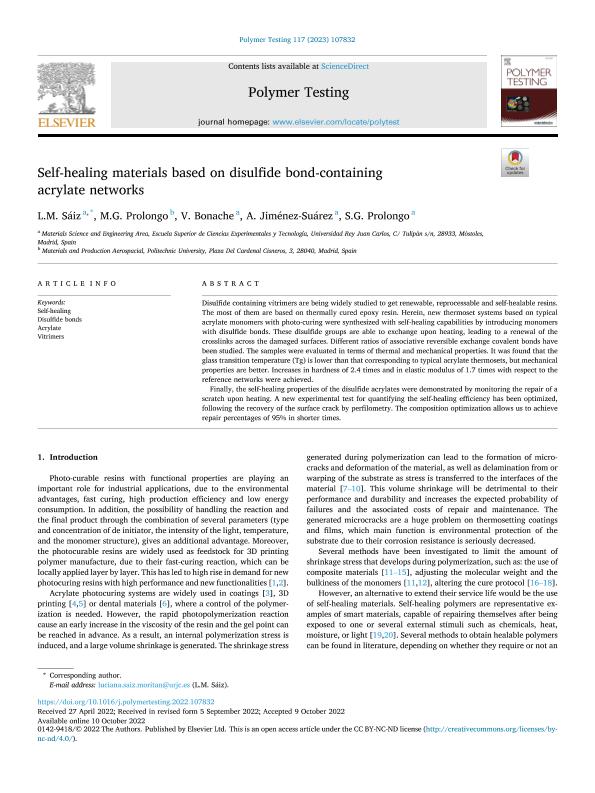Mostrar el registro sencillo del ítem
dc.contributor.author
Sáiz, Luciana María

dc.contributor.author
Prolongo, M. G.
dc.contributor.author
Bonache, V.
dc.contributor.author
Jiménez Suárez, A.
dc.contributor.author
Prolongo, S. G.
dc.date.available
2024-04-18T11:07:19Z
dc.date.issued
2023-01
dc.identifier.citation
Sáiz, Luciana María; Prolongo, M. G.; Bonache, V.; Jiménez Suárez, A.; Prolongo, S. G.; Self-healing materials based on disulfide bond-containing acrylate networks; Elsevier; Polymer Testing; 117; 1-2023; 1-9
dc.identifier.issn
0142-9418
dc.identifier.uri
http://hdl.handle.net/11336/233387
dc.description.abstract
Disulfide containing vitrimers are being widely studied to get renewable, reprocessable and self-healable resins. The most of them are based on thermally cured epoxy resin. Herein, new thermoset systems based on typical acrylate monomers with photo-curing were synthesized with self-healing capabilities by introducing monomers with disulfide bonds. These disulfide groups are able to exchange upon heating, leading to a renewal of the crosslinks across the damaged surfaces. Different ratios of associative reversible exchange covalent bonds have been studied. The samples were evaluated in terms of thermal and mechanical properties. It was found that the glass transition temperature (Tg) is lower than that corresponding to typical acrylate thermosets, but mechanical properties are better. Increases in hardness of 2.4 times and in elastic modulus of 1.7 times with respect to the reference networks were achieved. Finally, the self-healing properties of the disulfide acrylates were demonstrated by monitoring the repair of a scratch upon heating. A new experimental test for quantifying the self-healing efficiency has been optimized, following the recovery of the surface crack by perfilometry. The composition optimization allows us to achieve repair percentages of 95% in shorter times.
dc.format
application/pdf
dc.language.iso
eng
dc.publisher
Elsevier

dc.rights
info:eu-repo/semantics/openAccess
dc.rights.uri
https://creativecommons.org/licenses/by-nc-nd/2.5/ar/
dc.subject
ACRYLATE
dc.subject
DISULFIDE BONDS
dc.subject
SELF-HEALING
dc.subject
VITRIMERS
dc.subject.classification
Ingeniería de los Materiales

dc.subject.classification
Ingeniería de los Materiales

dc.subject.classification
INGENIERÍAS Y TECNOLOGÍAS

dc.title
Self-healing materials based on disulfide bond-containing acrylate networks
dc.type
info:eu-repo/semantics/article
dc.type
info:ar-repo/semantics/artículo
dc.type
info:eu-repo/semantics/publishedVersion
dc.date.updated
2024-04-17T12:32:22Z
dc.journal.volume
117
dc.journal.pagination
1-9
dc.journal.pais
Países Bajos

dc.journal.ciudad
Amsterdam
dc.description.fil
Fil: Sáiz, Luciana María. Consejo Nacional de Investigaciones Científicas y Técnicas. Centro Científico Tecnológico Conicet - Mar del Plata. Instituto de Investigaciones en Ciencia y Tecnología de Materiales. Universidad Nacional de Mar del Plata. Facultad de Ingeniería. Instituto de Investigaciones en Ciencia y Tecnología de Materiales; Argentina. Universidad Rey Juan Carlos; España
dc.description.fil
Fil: Prolongo, M. G.. Universidad Politécnica de Madrid; España
dc.description.fil
Fil: Bonache, V.. Universidad Rey Juan Carlos; España
dc.description.fil
Fil: Jiménez Suárez, A.. Universidad Rey Juan Carlos; España
dc.description.fil
Fil: Prolongo, S. G.. Universidad Rey Juan Carlos; España
dc.journal.title
Polymer Testing

dc.relation.alternativeid
info:eu-repo/semantics/altIdentifier/doi/http://dx.doi.org/10.1016/j.polymertesting.2022.107832
Archivos asociados
